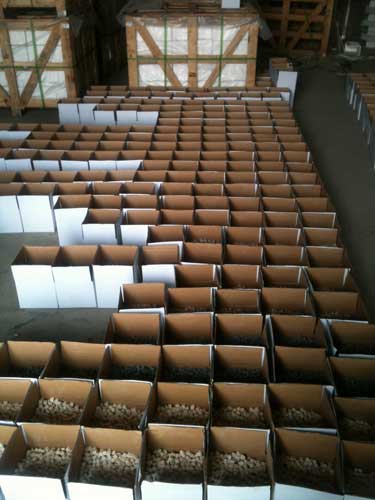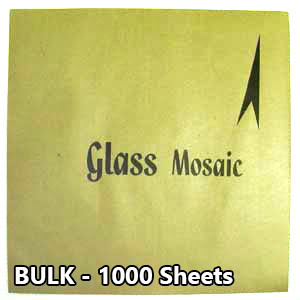
The Mosaic Glass Cutter is the recommended hand tool for cutting glass mosaic tile. This tool cuts glass up to 3/8-inch thick with minimal crushing and splintering, and it easily cuts molded tile into quarters, halves and triangles. It is also great for nipping up small pieces of stained glass, although it is not a scoring tool for making long straight cuts in stained glass. This is a compression tool similar to an ordinary tile nipper in the sense that you squeeze tile between the blades. Note that the circular blades do not actually rotate. Replacement blades are available, although the blades should last for years if you don’t abuse them by attempting to cut materials other than glass.
You should not use ordinary tile nippers to cut glass tile. Ordinary tile nippers were made for glazed ceramic tile, and they tend to crush and splinter glass. For most artists, the mosaic glass cutters tend to pay for themselves in what they save in wasted tile.
Safety and Cutting Tile
- Always wear safety glasses with side shields when using the cutters.
- Make sure that you don’t cut glass around people not wearing safety glasses. Flying chips could potentially hit their eyes as easily as yours.
- Never use a mosaic glass cutter to cut materials other than glass, especially hard porcelain. The wheel-shaped blades can shatter.
- Be aware that cutting glass tile can produce sharp tiny slivers. Never sweep off a work surface with your bare hand. Use a vacuum or counter brush.
Product Specifications
- steel hand plier with cushion grip
- replaceable carbide steel cutting blades
How To Cut Glass Tile
Hold the cutter over a cardboard box or plastic dishpan to catch broken pieces and tiny slivers.
Hold vitreous glass tile upside down when cutting so that you can see the embossed pattern of ridges on the bottom. Make sure you position the blade so that the ridges do not interfere with it. It is easier to cut across a ridge or in a crease between two ridges than it is to try to cut with the blade on top of a ridge where it can slip off.
Efficient Cutting
It is much easier to cut up four or five pieces of tile and choose the one that fits best than it is to try to trim one piece to a certain shape or size. It is quicker too. Keep your rejects in a small pile and pay attention to the shapes that are in it. If you don’t use a certain size or shape as often, try to cut fewer pieces like that. This is much more effective than trimming a piece down to what you need, and it is a lot less tedious.
Replacement Springs
Replacement Springs are available, but your cutters are not defective or useless if the springs fall off. The springs tend to fall of all hand tools eventually, even the most expensive brands. Keep your pinky fingers inside the handle instead of outside with the rest of your fingers and use that to open the tool. This is basic shop/studio practice for using any type of plier tool, most of which do not come with springs in the first place.
How To Make Mosaics
For more advice on designing your mosaic project or mounting, cutting, and grouting tile, please see our page of Mosaic Frequently Asked Questions or our Mosaic Information Guide, which lists instructional pages described by topic. We also post new articles about making mosaics at our How to Mosaic Blog.

 These are our 3/8″ marble mosaic tiles, which have a tumbled finish with natural colors that can be greatly enhanced merely by sealing with a stone enhancer instead of a regular tile and grout sealer. Building material stores usually sell both sealers.
These are our 3/8″ marble mosaic tiles, which have a tumbled finish with natural colors that can be greatly enhanced merely by sealing with a stone enhancer instead of a regular tile and grout sealer. Building material stores usually sell both sealers.
 Marble bars have one polished face because they are usually used as edging tile for mosaic floors made from larger stone tiles. Our artists use the marble bars as raw material for hand-cut tile.
Marble bars have one polished face because they are usually used as edging tile for mosaic floors made from larger stone tiles. Our artists use the marble bars as raw material for hand-cut tile.
 This photo shows just part of a two-ton shipment of stone being laid out for packing and crating.
This photo shows just part of a two-ton shipment of stone being laid out for packing and crating. 

